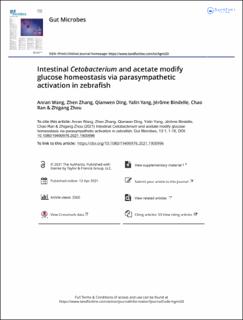| dc.contributor.author | Wang, Anran | |
| dc.contributor.author | Zhang, Zhen | |
| dc.contributor.author | Ding, Qianwen | |
| dc.contributor.author | Yang, Yaling | |
| dc.contributor.author | Bindelle, Jérôme | |
| dc.contributor.author | Ran, Chao | |
| dc.contributor.author | Zhou, Zhigang | |
| dc.date.accessioned | 2023-01-13T13:43:25Z | |
| dc.date.available | 2023-01-13T13:43:25Z | |
| dc.date.created | 2021-08-26T16:12:07Z | |
| dc.date.issued | 2021 | |
| dc.identifier.citation | Gut microbes. 2021, 13 (1), 1-15. | en_US |
| dc.identifier.issn | 1949-0976 | |
| dc.identifier.uri | https://hdl.handle.net/11250/3043422 | |
| dc.description.abstract | The capability of carbohydrate utilization in fish is limited compared to mammals. It has scientific and practical significance to improve the ability of fish to use carbohydrates. The efficiency of dietary carbohydrate utilization varies among fish with different feeding habits, which are associated with differential intestinal microbiota. In this study, we found that zebrafish fed with omnivorous diet (OD) and herbivorous diet (HD) showed better glucose homeostasis compared with carnivorous diet (CD) fed counterpart and the differential glucose utilization efficiency was attributable to the intestinal microbiota. The commensal bacterium Cetobacterium somerae, an acetate producer, was enriched in OD and HD groups, and administration of C. somerae in both adult zebrafish and gnotobiotic larval zebrafish models resulted in improved glucose homeostasis and increased insulin expression, supporting a causative role of C. somerae enrichment in glucose homeostasis in fish. The enrichment of C. somerae was constantly associated with higher acetate levels, and dietary supplementation of acetate promotes glucose utilization in zebrafish, suggesting a contribution of acetate in the function of C. somerae. Furthermore, we found that the beneficial effect of both acetate and C. somerae on glucose homeostasis was mediated through parasympathetic activation. Overall, this work highlights the existence of a C. somerae-brain axis in the regulation of glucose homeostasis in fish and suggests a role of acetate in mediating the axis function. Our results suggest potential strategies for improvement of fish carbohydrate utilization. | en_US |
| dc.language.iso | eng | en_US |
| dc.publisher | Informa UK Limited | en_US |
| dc.rights | Navngivelse 4.0 Internasjonal | * |
| dc.rights.uri | http://creativecommons.org/licenses/by/4.0/deed.no | * |
| dc.title | Intestinal Cetobacterium and acetate modify glucose homeostasis via parasympathetic activation in zebrafish | en_US |
| dc.title.alternative | Intestinal Cetobacterium and acetate modify glucose homeostasis via parasympathetic activation in zebrafish | en_US |
| dc.type | Peer reviewed | en_US |
| dc.type | Journal article | en_US |
| dc.description.version | publishedVersion | en_US |
| dc.source.pagenumber | 1-15 | en_US |
| dc.source.volume | 13 | en_US |
| dc.source.journal | Gut microbes | en_US |
| dc.source.issue | 1 | en_US |
| dc.identifier.doi | 10.1080/19490976.2021.1900996 | |
| dc.identifier.cristin | 1929060 | |
| cristin.ispublished | true | |
| cristin.fulltext | original | |
| cristin.qualitycode | 1 | |

